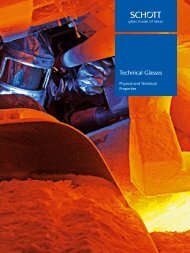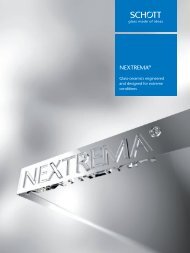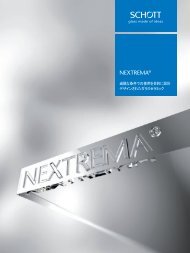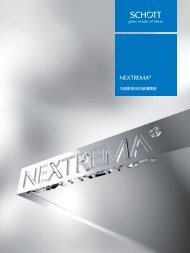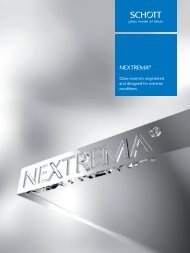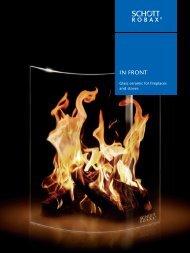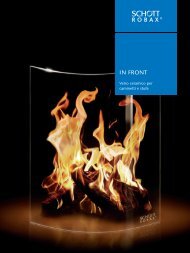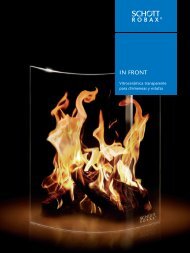Technology Magazine "SCHOTT solutions" Edition 2/2014
The SCHOTT solutions glass magazine features articles, reports and interviews on glass technological challenges from all over the world. The SCHOTT Technology Magazine. Beiträge, Reportagen und Interviews zu Lösungen von SCHOTT für technologische Herausforderungen weltweit.
The SCHOTT solutions glass magazine features articles, reports and interviews on glass technological challenges from all over the world.
The SCHOTT Technology Magazine. Beiträge, Reportagen und Interviews zu Lösungen von SCHOTT für technologische Herausforderungen weltweit.
Create successful ePaper yourself
Turn your PDF publications into a flip-book with our unique Google optimized e-Paper software.
pressure levels are thought to have overstrained the organic epoxy<br />
seals of electrical penetration assemblies (epas) at Fukushima,<br />
which are suspected to have led to the leakage of explosive hydrogen.<br />
An epa is a key part of the reactor containment, or safety<br />
barrier system, where electrical conductors pass through the containment<br />
to relay measurement data or supply high currents to<br />
operate reactor systems. If epas cannot withstand the same or<br />
greater conditions as the reactor containment, then they can become<br />
weak points that could fail during operation or an accident.<br />
schott designs and manufactures unique glass-to-metal epas<br />
which have ground-breaking performance in what is known as<br />
severe accident conditions, including high temperatures and pressures.<br />
Around 10,550 schott epas are used at nuclear sites and<br />
other safety-critical locations, such as liquefied natural gas installations<br />
and submarines, around the world. In terms of nuclear<br />
plants, schott epas have been used in over 50 nuclear power plants<br />
worldwide since the 1960s, for example Borssele in the Netherlands,<br />
Loviisa in Finland, and Forsmark in Sweden. It is a proven technology<br />
which has been improved and adapted over many years. Due<br />
to their high performance, the epas are now leading the field in the<br />
context of higher nuclear safety standards for components, which<br />
are aimed for after Fukushima. schott’s glass-to-metal epas avoid<br />
the problems suffered by components that utilize organic epoxy<br />
and Teflon material, which degrade over time in reactors. The high<br />
temperature, pressure and radiation in a reactor cause these materials<br />
to age and degrade, which does not happen with glass-to-metal<br />
seals. Nuclear component manufacturers are raising their safety<br />
specifications as a result of Fukushima, but there has been a consensus<br />
view in the nuclear industry, addressed at recent symposia, that<br />
standard-setting bodies should provide higher uniform standards<br />
to be applied globally. Organizations such as the International<br />
Atomic Energy Agency (iaea), the US Nuclear Regulatory Commission<br />
(nrc), the Institute of Electrical and Electronic Engineers<br />
(ieee), and the American Society of Mechanical Engineers (asme),<br />
are key bodies that set nuclear standards.<br />
schott epas were recently installed at Forsmark 3, a nuclear<br />
reactor north of Stockholm. The epas for this project were designed<br />
and stringently tested to provide the higher standards that were<br />
key to plant operator Forsmarks Kraftgrupp’s (a company of the<br />
Vattenfall Group) upgrading of the reactor, which included modified<br />
safety scenarios. The epas were designed to withstand submerged<br />
conditions under 13 meters of water for at least 30 days,<br />
together with pressures of up to 8.3 bar, and temperatures up to<br />
185 degrees Celsius. In addition, the radiological exposure of the<br />
epa during a severe accident scenario had to reach 1.7 MGy at a<br />
dose rate of 2360 Gy/h. Schott Nuclear Safety Division General<br />
Manager Thomas Fink said: “Our epas have been thoroughly tested<br />
and meet a number of high standards, which means that the epas<br />
will last for the Forsmark 3 life extension of 30 years.” epas are also<br />
a small part of the total cost of a new nuclear plant. Fink: “In terms<br />
of new build, the cost of these safety-critical components is only<br />
0.1 % of the entire budget, which is a small investment for a very<br />
significant increase in safety in a key part of the reactor.” Vattenfall<br />
schwemmung auf über 250 °C. Dabei wurde der geltende Auslegungsdruck<br />
um mehr als das Doppelte überschritten. Es wird angenommen,<br />
dass extrem hohe Temperatur- und Druckverhältnisse in<br />
Fukushima für die Überbeanspruchung der Epoxy-Kapselungen in<br />
den elektrischen Kabeldurchführungen verantwortlich waren, was<br />
schließlich zum Austritt explosiven Wasserstoffs führte.<br />
Eine Kabeldurchführung ist ein wesentlicher Bestandteil des<br />
Reaktorsicherheitsbehälters bzw. des Rückhaltesystems. In diesem<br />
übertragen elektrische Leiter Messdaten oder stellen Starkstrom<br />
zum Betrieb des Reaktors bereit. Wenn diese Durchführungen<br />
nicht gleichen oder kritischeren Anforderungen wie denen des<br />
Reaktorsicherheitsbehälters standhalten, besteht die Gefahr, dass<br />
sie sich zu Schwachstellen entwickeln, die während des täglichen<br />
Betriebs oder eines Unfalls versagen können.<br />
schott entwickelt und produziert einzigartige Glas-Metall-<br />
Durchführungen (sog. Electrical Penetration Assemblies = epas) mit<br />
hervorragenden Eigenschaften, die sowohl hohen Temperaturen<br />
als auch Überdruck im Falle schwerer Reaktorunfälle standhalten.<br />
Weltweit werden bereits rund 10.550 dieser schott Komponenten<br />
in Kernkraftwerken und an anderen sicherheitskritischen Standorten<br />
wie Flüssiggasanlagen oder in U-Booten verwendet. Seit den<br />
1960er-Jahren werden sie in über 50 Kernkraftwerken eingesetzt,<br />
HIGHER SAFETY<br />
The glass-to-metal penetration has been further developed for use in<br />
the Swedish nuclear power plant Forsmark 3 to prevent water from<br />
penetrating in the event of intentional flooding of the reactor or a core<br />
meltdown. The new schott product withstands the water pressure.<br />
HÖHERE SICHERHEIT<br />
Für das schwedische Kernkraftwerk Forsmark 3 wurde die Glas-Metall-<br />
Durchführung weiterentwickelt, um bei einer Kernschmelze und einer<br />
gezielten Flutung des Reaktors das Eindringen von Wasser zu verhindern.<br />
Das neue schott Produkt hält dem Wasserdruck stand. <<br />
Source Quelle : schott/ Alligator<br />
Protective shell<br />
Schutzhülle<br />
Water<br />
Wasser<br />
Reactor<br />
Reaktor<br />
Electrical<br />
penetration<br />
Elektrische<br />
Durchleitung<br />
43






